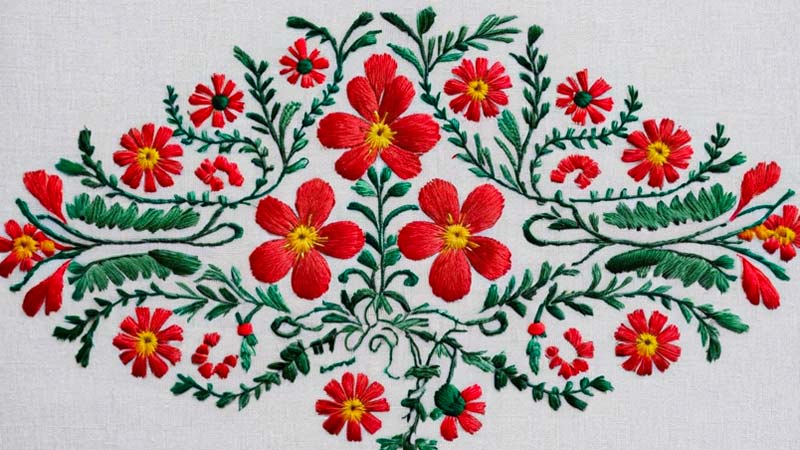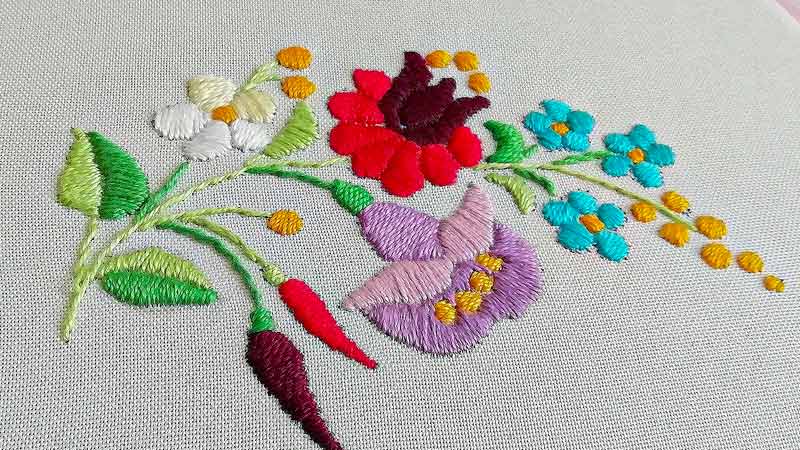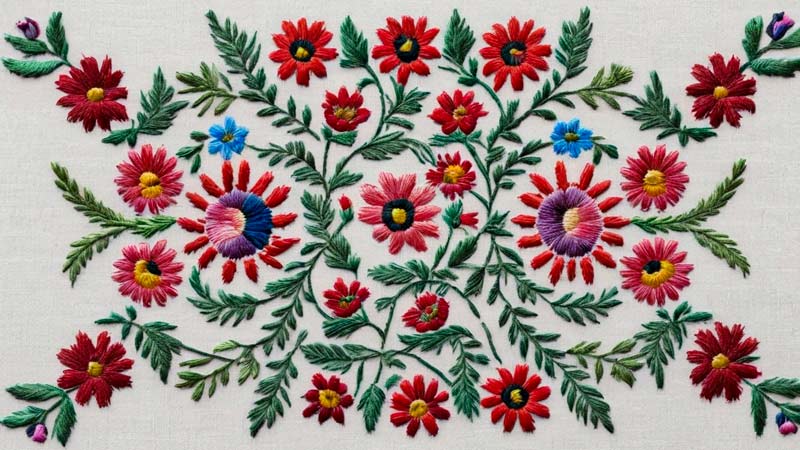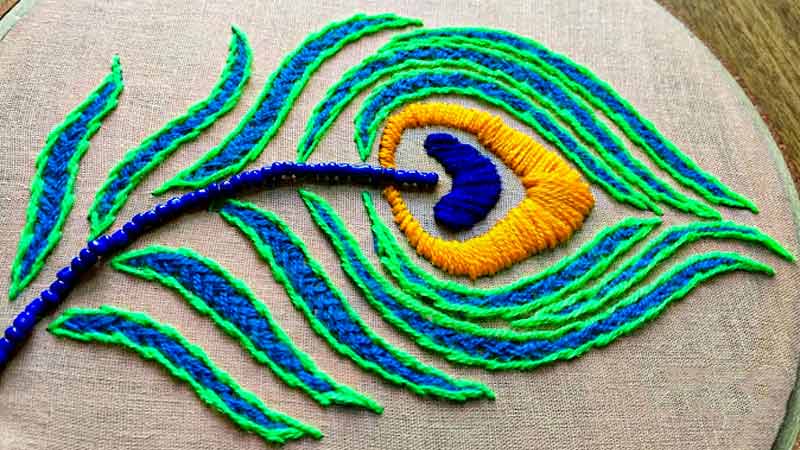Hungarian embroidery, known by its distinctive name “Kalocsai,” is a captivating tapestry of tradition and artistry deeply rooted in Hungary’s cultural fabric.
Originating from Kalocsa, this embroidery style has a rich history dating back centuries.
Renowned for its vibrant colors, intricate patterns, and symbolic motifs, Kalocsai embroidery reflects the essence of Hungarian folk culture.
Its distinctive use of stitches, such as satin and chain stitches, creates visually stunning and textured designs.
Beyond mere ornamentation, Hungarian embroidery is a cultural expression, telling stories of rural life, nature, and folklore.
This cherished craft continues to thrive today, serving as a testament to Hungary’s enduring cultural identity.

History of Hungarian Embroidery
Hungarian embroidery boasts a rich history dating back centuries. Originating from rural communities, it became an integral part of Hungarian folk culture.
The distinctive styles, notably the Kalocsai embroidery from the 19th century, evolved with influences from Turkish, Slavic, and Transylvanian traditions.
Embroidery adorned traditional garments, reflecting regional variations. Over time, it transitioned from a domestic craft to a symbol of national identity.
Despite socio-economic changes, Hungarian embroidery endures as a cherished cultural heritage, passed down through generations, maintaining its significance in preserving the country’s vibrant history and artistic traditions.
What Is Hungarian Embroidery Called?

The traditional Hungarian embroidery is called “Kalocsai” embroidery, named after the town of Kalocsa, which is renowned for its rich folk art heritage.
Hungarian embroidery is known for its vibrant colors, intricate patterns, and cultural significance.
Kalocsai embroidery is characterized by its bold, contrasting colors, such as red, blue, and black, often adorned with floral motifs and geometric designs.
The embroidery technique involves intricate stitching, including satin, chain, and stem stitch, creating a visually striking and textured surface.
These embroidered pieces are standard in traditional Hungarian folk costumes, tablecloths, and decorative items.
Beyond its aesthetic appeal, Hungarian embroidery carries cultural and symbolic meanings. The motifs often depict elements from nature, folklore, and the daily lives of the Hungarian people.
This traditional craft has been passed down through generations, preserving the country’s heritage and reflecting Hungarians’ pride in their unique cultural identity. Today, Hungarian embroidery continues to be a cherished and celebrated art form.
Hungarian Embroidery Patterns Free
While specific Hungarian embroidery patterns can be proprietary to individual artists or regions, some common motifs and designs are prevalent and often used in Hungarian embroidery.
Many of these patterns are characterized by vibrant colors, floral elements, and geometric shapes.
Here are popular Hungarian embroidery designs:
Floral Motifs

Hungarian embroidery’s fascination with floral motifs extends beyond roses to include a myriad of blossoms like tulips, daisies, and lilies.
Each flower is meticulously crafted with vibrant threads, creating a tapestry that mirrors the diverse flora of Hungary.
These intricate floral patterns symbolize nature’s beauty and reflect the country’s agricultural roots.
Bouquets and vines, skillfully arranged, bring a sense of harmony and grace to the embroidered pieces, capturing the essence of the Hungarian countryside in every stitch.
Peacock Eye Patterns

The mesmerizing Peacock Eye patterns, reminiscent of the intricate details found in peacock feathers, showcase Hungarian embroiderers’ unparalleled skill and precision.
These circular motifs, resembling the captivating eyespots on a peacock’s plumage, often create stunning focal points in embroidery.
The delicate interplay of colors and the meticulous arrangement of stitches contribute to the allure of these patterns, making them a captivating symbol of both nature’s beauty and the artisan’s mastery.
Matyó Patterns
Matyó embroidery, originating from Mezőkövesd, captivates with its bold and colorful designs. Flowers in Matyó patterns are often rendered in vivid hues, creating a visual feast for the eyes.
Geometric shapes, meticulously incorporated, add a sense of symmetry and balance to the overall composition.
This distinctive style, marked by its harmonious blend of vibrant colors and precise patterns, reflects the cultural richness of the Matyó region.
Matyó patterns, with their symmetrical allure, stand as a testament to the artistic ingenuity of Hungarian embroidery.
Folk Motifs
Hungarian embroidery is a repository of folk symbols and motifs, each telling a story deeply rooted in the country’s folklore, mythology, and daily life.
Animals like birds and horses, sun motifs representing vitality, and symbols imbued with cultural significance all find a place in these embroideries. The art becomes a visual narrative, preserving and celebrating the unique heritage of Hungary.
Each embroidered piece becomes a canvas for these folk motifs, intertwining the past with the present and fostering a sense of cultural continuity.
Cross-Stitch Patterns
Cross-stitch, a prevalent technique in Hungarian embroidery, unfolds a world of geometric precision and intricate designs.
These patterns often grace clothing and household items, showcasing the versatility of cross-stitching. Geometric shapes intertwine with floral and folk motifs, creating a harmonious blend of tradition and creativity.
The repetitive yet precise nature of cross-stitching adds a meditative quality to the craft, emphasizing the dedication and patience embedded in Hungarian embroidery.
Each cross-stitched piece becomes a unique testimony to the artisan’s skill and the enduring charm of this traditional technique.
FAQs
What is Hungarian embroidery called?
Hungarian embroidery is commonly referred to as “Kalocsai” embroidery.
This name is derived from Kalocsa, renowned for its rich folk art heritage and contribution to this distinctive embroidery style.
Are there specific motifs associated with Hungarian embroidery?
Yes, Hungarian embroidery is known for its diverse motifs.
Where does Matyó embroidery originate from?
Matyó embroidery hails from the town of Mezőkövesd in Hungary.
Is Hungarian embroidery only used for traditional clothing?
While Hungarian embroidery has a strong presence in traditional clothing, it extends beyond that.
It also embellishes tablecloths, decorative pieces, and household items.
Wrap Up
The artistry and cultural significance embodied in Hungarian embroidery, known as “Kalocsai,” is a testament to the nation’s enduring heritage.
Through centuries, this vibrant tapestry of colors, intricate stitches, and symbolic motifs has woven tales of rural life, folklore, and national identity.
The distinctiveness of Kalocsai embroidery, originating from the town of Kalocsa, encapsulates Hungary’s rich history and artistic traditions.
Beyond being a mere craft, it is a cherished cultural legacy passed down through generations.
As this timeless tradition persists, Hungarian embroidery continues to be a source of pride, connecting past and present and showcasing the enduring beauty of Hungary’s cultural identity.
Leave a Reply